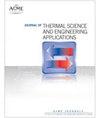Variable Thermal Conductivity Metamaterials Applied to Passive Thermal Control of Satellites
IF 1.4
4区 工程技术
Q3 ENGINEERING, MECHANICAL
引用次数: 0
Abstract
Active materials, such as the proposed variable thermal conductivity metamaterial, enables new thermal designs and low-cost, low-power, passive thermal control. Thermal control of satellites conventionally requires active thermal control systems that are expensive, large, inefficient, energy-intensive, and unavailable for CubeSats. For CubeSats, the thermal system's primary design consideration is the high-temperature operation case. The thermal path is designed to reject as much heat as possible to prevent overheating. In other cases, such as during a power anomaly, the oversized thermal path results in rapid cooling, culminating in mission failure due to thermal limits on the electronics or batteries. Improving the thermal control of CubeSats can enable new thermally challenging missions, increase satellite longevity, and increase mission success rate by controlling and dynamic thermal environment. The materials available for thermal management are limited, but new engineered materials provide unique opportunities to change how satellites adapt to dynamic environmental and thermal loads. This paper investigates using an adaptive metamaterial designed to passively change its thermal conductivity as a function of temperature to meet the needs of the satellite. The thermal performance of a CubeSat is evaluated with a variable thermal conductivity metamaterial located in the critical thermal path from the satellite to the radiator. The system's performance using two metamaterial configurations is compared to a baseline copper thermal path. Multiple satellite thermal operation cases are investigated to determine the operation ranges, and the metamaterial's performance in various conditions is quantified.可变导热系数超材料在卫星被动热控制中的应用
活性材料,如提出的可变热导率超材料,使新的热设计和低成本,低功耗,被动热控制成为可能。卫星的热控制通常需要主动热控制系统,这种系统昂贵、体积大、效率低、耗能大,而且立方体卫星无法使用。对于CubeSats,热系统的主要设计考虑是高温操作情况。热路径的设计是为了尽可能多地排除热量,以防止过热。在其他情况下,例如在电源异常期间,超大的热路径导致快速冷却,最终导致任务失败,因为电子设备或电池的热限制。通过控制和动态热环境,改进立方体卫星的热控制可以实现新的热挑战性任务,延长卫星寿命,提高任务成功率。可用于热管理的材料是有限的,但是新的工程材料提供了独特的机会来改变卫星如何适应动态环境和热负荷。本文研究了利用自适应超材料被动改变其导热系数作为温度的函数来满足卫星的需要。立方体卫星的热性能是用位于从卫星到散热器的关键热路径上的可变导热系数超材料来评估的。使用两种超材料配置的系统性能与基准铜热路径进行了比较。研究了多个卫星热运行工况,确定了运行范围,量化了各种工况下超材料的性能。
本文章由计算机程序翻译,如有差异,请以英文原文为准。
求助全文
约1分钟内获得全文
求助全文
来源期刊

Journal of Thermal Science and Engineering Applications
THERMODYNAMICSENGINEERING, MECHANICAL -ENGINEERING, MECHANICAL
CiteScore
3.60
自引率
9.50%
发文量
120
期刊介绍:
Applications in: Aerospace systems; Gas turbines; Biotechnology; Defense systems; Electronic and photonic equipment; Energy systems; Manufacturing; Refrigeration and air conditioning; Homeland security systems; Micro- and nanoscale devices; Petrochemical processing; Medical systems; Energy efficiency; Sustainability; Solar systems; Combustion systems
 求助内容:
求助内容: 应助结果提醒方式:
应助结果提醒方式:


